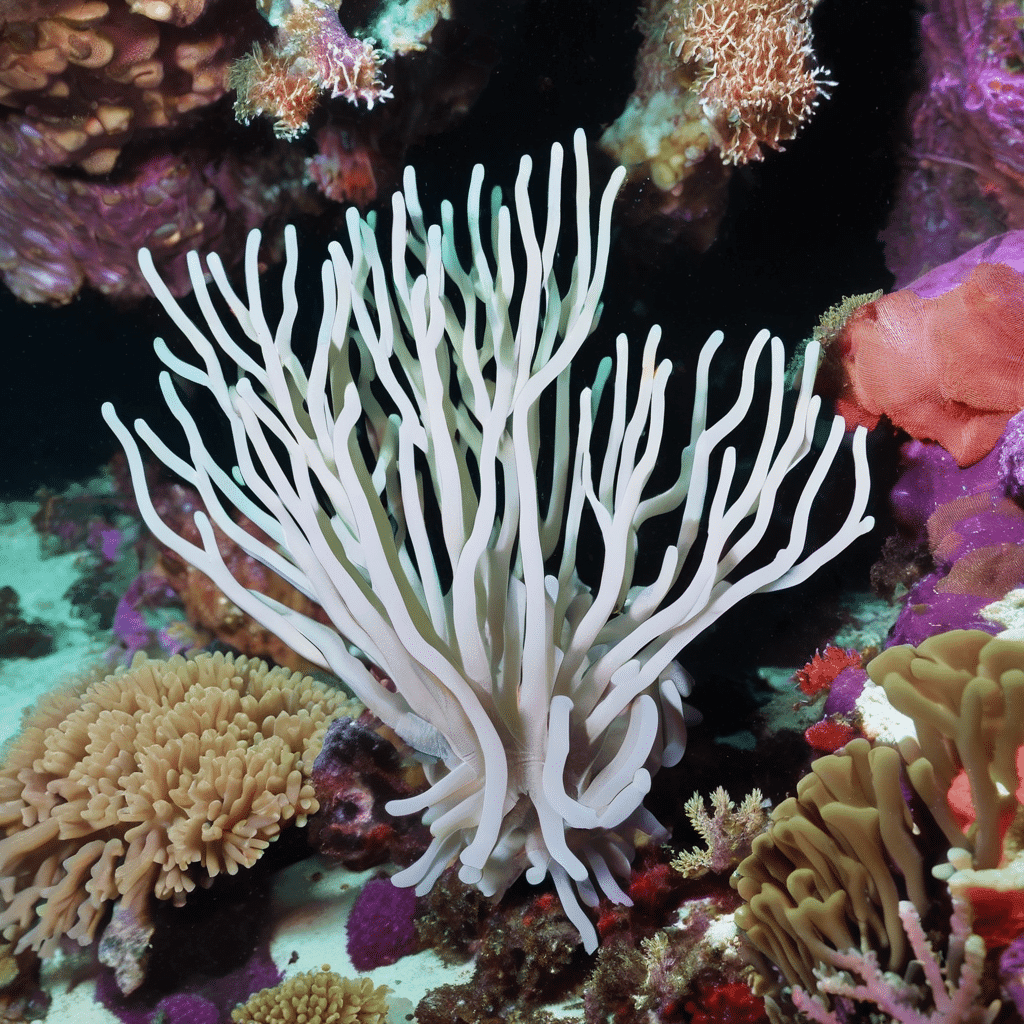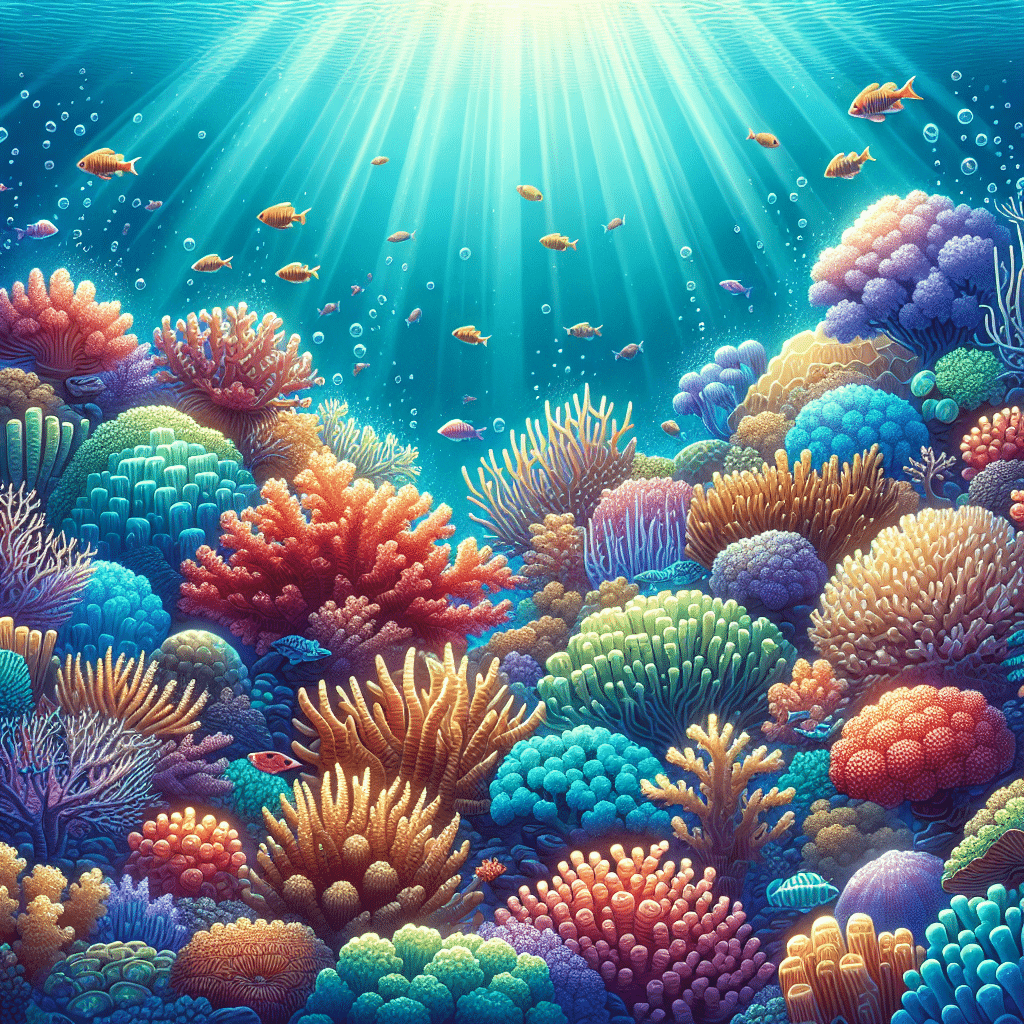Understanding Organ Pipe Coral
Introduction to Tubipora Musica
I’ve always found organ pipe coral to be fascinating. The scientific name for this unique coral is Tubipora musica, and it’s the only known species in its genus. Native to the Indian Ocean and the central and western regions of the Pacific Ocean, it thrives in shallow waters, typically at depths ranging from 2 to 20 meters. The coral forms colonies that have a remarkable structure, featuring a hard skeleton made of calcium carbonate with numerous organ pipe-like tubes. Each tube houses a series of polyps adorned with eight feather-like tentacles, which are crucial for capturing prey. The living colonies often display vibrant colors, such as green, blue, or purple, due to the expanded polyps (Britannica, Wikipedia).
Habitat of Organ Pipe Coral
The habitat of organ pipe coral is quite specific. It prefers shallow, sheltered waters with good lighting, which is essential for its survival. These corals are typically found on reefs, where they can benefit from medium to strong water currents and well-oxygenated environments. The ideal conditions for organ pipe coral include sufficient alkalinity and calcium, which are vital for maintaining their calcium carbonate structures.
| Habitat Feature | Description |
|---|---|
| Depth Range | 2 to 20 meters |
| Light Conditions | Bright light |
| Water Currents | Medium to strong |
| Water Quality | Well-oxygenated with adequate alkalinity and calcium |
The organ pipe coral colonies form interconnected networks of pipes and tubes that create a stunning visual display. The polyps, which only inhabit the tops of these tubes, contain zooxanthellae, a symbiotic type of phytoplankton that provides energy for the coral. This relationship is crucial for their growth and survival, allowing them to thrive in their natural habitat (Dimensions, Wikipedia).
For those interested in incorporating this stunning coral into their reef tanks, understanding its habitat requirements is key to ensuring a healthy environment. If you’re exploring other types of corals, you might want to look into brain coral or mushroom coral for more options in your tank.
Characteristics of Organ Pipe Coral
Structure and Appearance
The Organ Pipe Coral, scientifically known as Tubipora musica, boasts a unique and striking structure. Its skeleton consists of calcite spicules that are fused into upright, parallel tubes, which are then connected by transverse platforms. This distinctive arrangement not only gives the coral its name but also sets it apart as the only known hard, calcitic, reef-building alcyonarian (soft) coral (WA Museum).
The living colonies of Organ Pipe Coral are quite colorful, typically appearing in shades of green, blue, or purple, thanks to the color of the expanded polyps. Each polyp is adorned with eight feather-like tentacles, adding to the coral’s overall allure. The colonies can reach impressive sizes, forming dome-shaped structures that may expand up to 3 meters across (Wikipedia).
| Feature | Description |
|---|---|
| Skeleton Type | Hard, calcitic with tubular structure |
| Tube Color | Bright red due to organic pigments |
| Typical Colors of Polyps | Green, blue, or purple |
| Maximum Colony Diameter | Up to 3 meters |
Growth and Size
The growth pattern of Organ Pipe Coral is fascinating. Colonies typically range between 11.8 to 19.7 inches (30 to 50 cm) in diameter, and they can grow to a height of about 7.9 to 11.8 inches (20 to 30 cm) (Dimensions). These corals are generally found in shallow waters, thriving at depths of 2 to 20 meters where they can access good light conditions and experience medium to strong water currents.
This coral species is commonly found across the Indian Ocean and central and western Pacific regions. The ideal habitat for Organ Pipe Coral includes well-oxygenated waters with sufficient alkalinity and calcium, which are essential for their growth and overall health. The interconnected network of pipes and tubes that form the colonies allows for efficient nutrient sharing and resilience against environmental changes (Wikipedia).
By understanding the structure and growth patterns of Organ Pipe Coral, I can appreciate its unique role in the reef ecosystem and its beauty in my fish tank. For more information about different types of corals, feel free to explore our articles on corals, brain coral, or mushroom coral.
Care Tips for Organ Pipe Coral
Taking care of Organ Pipe Coral (Tubipora musica) can be a rewarding experience for reef tank hobbyists. Here are some essential tips on lighting, placement, and water flow to ensure your coral thrives.
Lighting and Placement
Organ Pipe Coral thrives in low to medium lighting conditions. It’s important to find a balance that allows the coral to receive enough light without being overwhelmed. Placing it in a well-lit area of your reef tank can help it grow and flourish. Here’s a quick guide for lighting preferences:
| Lighting Level | Recommended Range |
|---|---|
| Low | 50-100 PAR |
| Medium | 100-200 PAR |
Make sure to secure the coral to the rockwork in a stable position to prevent movement, especially in areas with water flow. This will help the coral avoid damage and ensure it remains healthy. The coral does best in shallow and sheltered areas, mimicking its natural habitat found in the Indian Ocean and the central and western Pacific (Dimensions).
Water Flow and Algae Prevention
Medium to high water flow is ideal for Organ Pipe Coral. This helps prevent algae buildup on its calcium base, which can hinder the extension of its polyps. For optimal placement, consider these flow recommendations:
| Water Flow Rate | Description |
|---|---|
| Medium | Gentle currents that allow for some movement of the coral |
| High | Stronger currents that keep algae at bay and promote healthy growth |
To reduce algae accumulation, position the Organ Pipe Coral in a part of the aquarium where it receives consistent, moderate to high flow. This will not only help keep the coral clean but also support its overall health.
By ensuring the right lighting and water flow conditions, you can create a thriving environment for your Organ Pipe Coral. For more information on coral care, feel free to check out related articles on corals and specific coral types like brain coral and mushroom coral.
Feeding and Maintenance
Taking care of organ pipe coral (Tubipora musica) is essential to keep it thriving in my reef tank. Understanding its feeding requirements and propagation techniques can make a big difference in its health and growth.
Feeding Requirements
Organ pipe coral can do pretty well without additional feeding if it has access to good quality lighting. However, I often supplement their diet with smaller, particle-sized foods like Reefroids or other prepared foods to enhance their growth and color. This coral features polyps that capture prey and organic particles from the water, thanks to the zooxanthellae they host, which provide them with energy.
To give you an idea of the feeding preferences, here’s a quick reference:
| Food Type | Description |
|---|---|
| Reefroids | Small, particle-sized food for corals |
| Prepared Foods | Nutrient-rich options for coral feeding |
| Plankton | Natural food source in the tank |
Keeping an eye on the water quality and ensuring it’s clean will also help the coral thrive.
Propagation Techniques
For those interested in propagating organ pipe coral, it’s a straightforward process. Due to its slower growth rate, I usually propagate it by carefully snapping apart polyps at their calcium base. Once separated, I can glue the fragments to suitable spots in my tank. This technique helps in expanding my coral collection while ensuring the health of each piece.
Here’s the basic propagation method:
- Identify Healthy Polyps: Choose healthy and well-established polyps for propagation.
- Snap Apart: Gently snap the polyps at their calcium base.
- Glue Fragments: Use coral-safe glue to attach the fragments to a rock or substrate in my tank.
- Monitor Progress: Keep an eye on the newly placed fragments to ensure they acclimate well.
With the right care and attention to feeding and propagation, organ pipe coral can add a beautiful variety to my aquarium. For more insights on coral care, check out our articles on brain coral, mushroom coral, and torch coral.
Unique Features of Organ Pipe Coral
Behavior and Interactions
I find the behavior of organ pipe corals fascinating. These corals exhibit limited colonial behavior, meaning they react as a unified colony when one part is disturbed. If you poke one section, you’ll notice a wave of activity sweep across the entire colony. This reaction is due to their ability to respond to both electrical and mechanical stimulation (Wikipedia).
The polyps of organ pipe coral only live in the tops of the colony’s tubes. These polyps contain zooxanthellae, a type of phytoplankton that provides energy for the coral. The eight feathery tentacles of each polyp branch out, giving the colony its vibrant color while allowing it to capture prey and organic particles from the surrounding environment. I always enjoy watching how these tentacles move and interact with the water flow in my tank.
Conservation Status
It’s important to be aware of the conservation status of organ pipe coral. Currently, it is listed as a near threatened species, with over 50% of the population being lost in the past decade. The increasing popularity of organ pipe corals among hobbyists, dealers, and even the medical community has led to illegal harvesting and smuggling. This is why it’s crucial for us as reef tank enthusiasts to promote responsible sourcing and care for these beautiful corals.
Scientists are advocating for increased protection for organ pipe corals. This includes establishing protected areas, running awareness campaigns, and even exploring the potential for farming these corals. As hobbyists, we can support these efforts by choosing sustainably sourced corals and spreading the word about their conservation needs. For more information on different types of corals, check out our articles on brain coral and bubble coral.
Threats to Organ Pipe Coral
Organ pipe coral, or Tubipora musica, faces several serious threats that can impact its survival and existence. Understanding these threats is crucial for hobbyists and conservationists alike, so let’s dive into two major concerns: coral diseases and illegal harvesting and trade.
Coral Diseases
Coral diseases are a significant threat to organ pipe coral. One of the most severe diseases affecting corals today is Stony Coral Tissue Loss Disease (SCTLD). First identified in the Florida Keys in 2014, SCTLD has rapidly spread throughout the Caribbean, becoming one of the most lethal coral diseases ever recorded (EPA Coral Reefs). This disease attacks the coral tissue, leading to rapid tissue loss and often resulting in death.
Organ pipe corals are not immune to such diseases. The increase in water temperatures, pollution, and other environmental stressors can weaken the corals, making them more susceptible to infections. Monitoring coral health and being aware of disease outbreaks is crucial for anyone interested in keeping organ pipe coral in their reef tanks.
Illegal Harvesting and Trade
Illegal harvesting and trade pose another significant threat to organ pipe coral. This species is listed as near threatened, with over 50% of the population lost in the past ten years. Its appealing bright red skeleton makes it a target for collectors, dealers, and the jewelry trade. Organ pipe coral is one of the fifteen most traded corals globally, leading to rampant illegal harvesting and smuggling.
The demand for organ pipe coral in the aquarium industry, as well as its use in medical and scientific communities, only exacerbates this issue. Conservationists are calling for increased protection measures, including the establishment of protected areas and awareness campaigns regarding the ecological importance of these corals. There’s also a push for investigating the potential for farming these corals to reduce illegal collection efforts (WA Museum).
Given these threats, it’s important for hobbyists to source their organ pipe coral responsibly and to support conservation efforts aimed at protecting this beautiful species.



